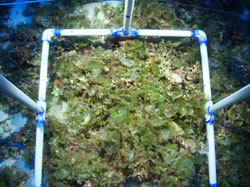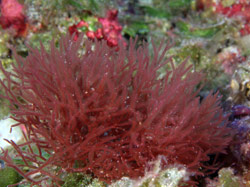
Deep Coral Reef Expedition Discovers new fish and habitat in Papahānaumokuākea
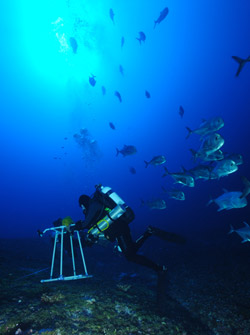
NOAA scientific diver followed by large ulua while conducting coral reef surveys at Pearl and Hermes Atoll, 200 feet. Credit: Greg McFall/NOAA
On Friday, September 28, 2012, researchers returned from 25 days of conducting research in Papahānaumokuākea Marine National Monument. The team's mission was to explore mesophotic coral ecosystems – deep coral reefs – of the Northwestern Hawaiian Islands (NWHI) using technical diving gear.
Scientists on this cruise dived to depths up to 250 feet – well beyond typical coral reef research occurring in less than 100 feet of water – using advanced mixed gas technical diving methods. While exploration of these deep habitats has been ongoing for three years in the Monument, this year the team used rebreather scuba diving technology for the first time.
"Rebreathers allow divers to go deeper and stay longer while minimizing the need for lengthy decompression before surfacing," said Randy Kosaki, NOAA Chief Scientist on the cruise.
Initial discoveries from the research are exciting.
Numerous sightings and observations of fishes never before recorded in the NWHI were documented. The exploration of deep reefs by divers has increased the number of fishes known in the NWHI by about 25%.
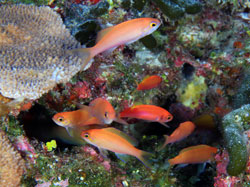
Juvenile reef fish (Fairy Basslets, Pseudanthias thompsoni and Pseudanthias earlei) in deep water juvenile nursery habitat. Pearl and Hermes Atoll, 200 feet. Credit: Greg McFall/NOAA
Another highlight was the discovery of a completely new type of coral reef habitat: nursery grounds for deep coral reef fishes in over 200 feet of water. Juvenile fishes of many species, most just 1-to-2 inches in length, hide in deep water algal beds until they are large enough to avoid predation and survive in adult habitats. Researchers also collected specimens of ten probable new species of algae and several probable new species of corals, sponges, and hydroids. Experts at the University of Hawaiʻi Department of Botany and the Smithsonian Institution will be examining these specimens in coming weeks.
In addition, studies of seawater acidification and carbonate chemistry in relation to climate change were conducted by two graduate students from Hawaiʻi Pacific University. This research will establish a baseline against which future environmental changes can be compared.
"Global climate change caused by rising atmospheric carbon dioxide concentrations is a major threat to the world's coral reef ecosystems," says Andrea Kealoha, a graduate student at Hawaiʻi Pacific University. "Of particular concern is that the gradual acidification of seawater, caused by increased CO2 levels, will reduce growth rates by reef-building corals, and may eventually dissolve the structure of the reef itself."
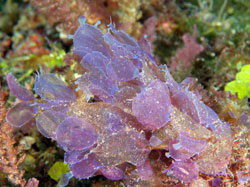
Unidentified red algae (probable new species) at 200 feet, French Frigate Shoals. Credit: Greg McFall/NOAA
Critically acclaimed Native Hawaiian artist Solomon Enos was invited to join the research expedition to experience the NWHI and interpret these islands and reefs through art. Enos' paintings will be on display at various public galleries in Honolulu later this year.
A three-person documentary team working for the Office of Hawaiian Affairs accompanied the expedition to film terrestrial cultural and natural resources. Footage from the OiwiTV team can be seen on their Vimeo site (see links to the videos here).
Expedition participants included staff from Papahānaumokuākea Marine National Monument, Hawaiian Islands Humpback Whale National Marine Sanctuary, Gray's Reef National Marine Sanctuary, Hawaiʻi Pacific University, University of Florida, Bishop Museum, Hawaiʻi Institute of Marine Biology, and Palikū Documentary Films/OiwiTV.
To see the press release, click here.
